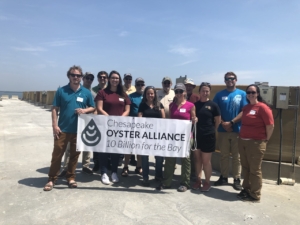Working Together to Keep Oysters Thriving in the Bay
A thriving oyster population is vital to a healthy Chesapeake Bay. As a keystone species, oysters are necessary for filtering water and providing critical habitat for other species in the Bay.
The Chesapeake Oyster Alliance is a coalition of partners that includes non-profits, universities, oyster farmers, and others, working toward adding 10 billion oysters to the Chesapeake Bay by 2025. Audrey Swanenberg, manager of the Chesapeake Oyster Alliance, spoke about the formation of the Alliance, restoration efforts so far, and the future of oysters in the Bay.
Behind the Alliance

Chesapeake Oyster Alliance partners touring UMCES’s Horn Point Lab during the spring 2019 partner meeting. Credit: Chesapeake Bay Foundation Staff Photo
The Chesapeake Oyster Alliance began with the Chesapeake Bay Foundation’s Making History Campaign which set goals of adding 10 billion new oysters in the Bay, planting 10 million trees across Pennsylvania, and engaging 1 million advocates for clean water. Restoring 10 billion oysters is no small feat and requires cooperation and partnership from organizations along the Chesapeake Bay.
The Chesapeake Research Consortium (CRC), and several of its member institutions, including the Virginia Institute of Marine Science (VIMS), University of Maryland Center for Environmental Science (UMCES), and Smithsonian Environmental Research Center (SERC), sit on the science advisory board. “Collectively, our role is to bring the best science to the mission and goals of the Alliance,” said Bill Ball, CRC Executive Director. Swanenberg echoed Ball’s statement, “It’s really important that we follow the latest science. We pride ourselves on being a science-based coalition. Having a science committee and scientific partners is very important.”
Progress in the Bay
Efforts by the Alliance are based on restoring oysters through sanctuaries, improving science-based fishery management, and increasing oyster aquaculture. The Alliance is supporting restoration through the 10 tributaries strategy, outlined in the 2014 Chesapeake Bay Watershed Agreement. The goal is to restore oyster populations to 10 tributaries along the Bay by 2025. “We need the 10 tributaries strategy to be fully implemented to achieve our 10 billion goal,” stressed Swanenberg.
Science-based fishery management, such as periodic stock assessments of oysters, would help support the oyster harvest industry in the long-term. Swanenberg explained that there has not been an assessment of the oyster stock in Virginia, which creates challenges in understanding that state’s overall oyster population. The Alliance is advocating to get a stock assessment in Virginia. “If you don’t know the state of the resource, it’s hard to know how best to manage it,” said Swanenberg.

Jesse Illiff (Arundel Rivers Federation) and Bill Ball (CRC) take a look at young aquaculture seed oysters at the nursery at Orchard Point Oysters Company on Kent Island during the field experiences portion of the spring 2019 partner meeting. Credit: Audrey Swanenberg, Chesapeake Oyster Alliance
Oyster aquaculture has been occurring in the Bay since the 1800s and Swanenberg emphasized the important role of aquaculture in keeping up with consumer demand for oysters. “We have people asking for Chesapeake oysters and that public support,” she said. She also pointed out that people are attracted to oysters because “research shows that oysters are a great source of protein, but they also have a small carbon footprint.”
While progress reports are not public yet, Swanenberg said that starting in December, the Alliance is hoping to start providing public progress announcements. Moving forward, the Alliance plans to release reports updating restoration numbers twice a year, in December and June.
Oysters for the future
Achieving 10 billion oysters in the Bay is not without its challenges. Swanenberg shared that the biggest hurdles to achieving this lofty goal are budgets and policies. “There is always more that could be done with a bigger budget,” she stated. “That’s why the Alliance advocates for securing funding for oysters at the state and federal level.”
“That’s why there is a need for robust support for restoration, aquaculture, and science-based fisheries management,” emphasized Swanenberg. “You really can’t have a restored Bay without oysters. They’re just such an important keystone species.”
